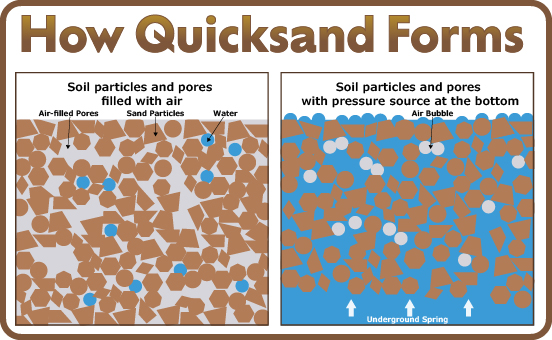Quicksand: a case of liquefaction
Quicksand is an interesting natural phenomenon that happens when soil begins to act more like a liquid than a solid. The "quick" refers to how easily the sand (soil particles) shifts when in this semi-liquid state.
First the Sand …
Though soil may seem solid, it is really a mixture of particles (sand, silt, clay) of different sizes with pores (spaces) between them. As the name implies, most of the particles in quicksand are usually sands (although some silts can be “quick).” While most soils have structure (aggregates that are clumps of soil particles held together by soil “glues”), sands are typically without structure.
So how does a sandcastle stay together? As a kid, you might have discovered that you can’t build a sandcastle with dry sand. Why? Friction and gravity are the only forces at work in dry sand. Sand grains have rough edges and irregular shapes. In dry sands, these shapes help “lock’ the sand grains together so that while gravity tries to pull the sand into a flat layer, the friction of the rough edges causes the sand to form a mound. Then, water adds two more forces to the mix: adhesion – the attraction of water for the sand particles, and cohesion – the attraction of water molecules for other water molecules. In a wet and unsaturated sand, the combination of adhesion and cohesion creates a tension that pulls the particles together, thus keeping a sandcastle together.
Then the “Quick”…
In sandy soil the solid particles might comprise 60 to 65% of the total volume. The other 35 to 40% of total volume comprises the pores, the empty space between the particles. However, the space is not really empty – it is always filled with air and/or water. In dry sand less than 5% of the pore volume would be water and in an almost saturated sand, less than 5% of the pore volume would be air. Soil is saturated when its pores are almost completely filled with water, essentially forming a soupy mixture of soil particles and water.
The saturated soil becomes “quick” when it is suddenly agitated. When the water trapped in the pores can’t escape, the tension that held the sand particles together becomes a pressure that pushes them apart, creating a liquefied soil. There are two ways in which these soils can become agitated enough to create quicksand:
- Flowing underground water - The force of an upward water flow opposes the force of gravity, pushing the particles apart, causing the soil particles to become more buoyant. Examples include natural springs and water from lakes and oceans coming from underneath the soil.
- Earthquakes - The force and vibration of the shaking ground can increase the pressure of shallow groundwater, which liquefies sand and silt deposits.

Quicksand diagram, Soil Science Society of America
The liquefied soil loses strength and can cause buildings or other objects on the surface to sink or fall over. While quicksand can occur in almost any location where water is present, there are certain locations where it's more likely to be found, such as riverbanks, beaches, lake shorelines, marshes and near underground springs.
The next time you're at the beach, notice the difference in the sand as you stand at different parts of the beach. Stand on the driest part of the beach - the sand at the surface may be loose but still holds you up just fine. The friction between the sand particles creates a stable surface. As you move closer to the water, you'll notice the moist sand is firmer than the dry sand. In a moist sand, the adhesion and cohesion create a tension that holds the particles together.
However, move right to the shoreline and as the waves come in, you’ll feel the “quick”. Why? The force of the waves not only pushes water over the surface onto the beach, but also into the pores in the sand under the surface. After the wave recedes, notice the surface glistens for a few seconds as the water soaks back into the soil.
So why aren’t all beaches quicksand? The water at the beach is in the sand and on top when the wave comes in. Quicksand occurs when the sand becomes saturated AND there is water pressure/vibration in the sand. We can make shoreline soils act like quicksand by wiggling our feet which pressurizes the water, forcing the air out and pushing the sand and soil particles apart.
So why is it different when you stand in water up to your knees? The weight of the water pushing down on the sand had already pushed most of the air out and holds the sand in place.
How to Escape Quicksand
If you ever find yourself in a pit of quicksand, don't worry-- it's not going to swallow you whole, and it's not as hard to escape from as you might think. With quicksand, don't panic! The more you struggle, the faster you will sink. If you just relax, your body will float because your body is less dense than the quicksand. While quicksand remains the hackneyed convention of bad adventure movies, there's very little to be afraid of in real Iife. As long as you keep a cool head in the situation, the worst result will be a shoe full of wet sand.
Want to learn more? Bring this Quicksand Activity into your classroom!



